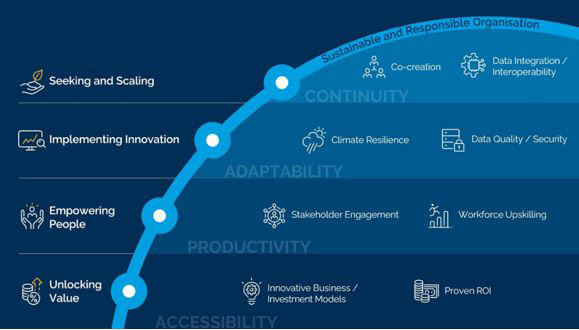Scaling Smart Water: Balancing Automation With Continuous Value
By Dr. Amir Cahn, CEO and Shirley Ben-Dak, Senior Advisor (SWAN Forum)
The term “scaling” can mean many different things in the water sector. It's not just about speed and automation, but also increasing workforce productivity, adapting to diverse situations like weather extremes, and providing continuous value, often through co-creation. It’s also not just about scaling “up”, but scaling down to provide more accessible and equitable solutions such as to smaller systems, rural communities, and developing countries.
Successful scaling relies on taking a holistic approach and balancing internal factors and external influences, from investing in people and processes to deploying the latest innovative solutions. These ideas are depicted in the modified image above based on the Accenture ‘Future Ready’ model.
Let’s explore how water utilities can scale smart water solutions through four key pillars: unlocking value, empowering people, implementing innovation, and scaling digitization.

Unlocking Value
Scaling smart water begins with understanding what creates true value for utilities and communities. Resource optimization is crucial, identifying opportunities to repurpose existing infrastructure and integrate new technologies that maximize system performance. For example, developing collaborative approaches with other urban systems (energy, transportation) creates shared value and reduces duplication of efforts. Some unique examples of this are reflected in smart metering projects (from EPCOR, Canada to Saldanha Bay, South Africa) that leverage gas and energy infrastructure to reduce communication related costs and boost local economic development efforts.
Empowering People
People are the foundation of any successful smart water initiative. As such, their engagement is key to unpacking potential. Internally, utilities should focus on developing talent through training programs that build data capacity such as analysis and storytelling skills, and adaptive management. This can help provide validation for more technology adoption across all utility levels and departments. Externally, engaging communities from a project’s onset ensures solutions address real needs and gain public support, especially critical in rate-sensitive communities where further technology investment may need to be justified. Overall, it’s essential to create environments where employees feel empowered to experiment and take calculated risks.
Implementing Innovation
Innovation in the water sector requires both technological advancement and organizational adaptability. Utilities should develop flexible procurement systems that can evolve with changing conditions and technological advancements. This often involves a phase-based approach with clear performance metrics. Partnering with technology providers, research institutions, and other utilities enables knowledge and resource sharing. For example, SWAN Members Specific Energy and Qatium allow their joint utility customers to access calibrated pump energy data across a simulated hydraulic model.
Scaling Digitization
After successfully implementing new innovations, how can a utility take their operations to the next level? There are several avenues. One is data interoperability, developing digital architectures that allow different technologies to work together seamlessly. Another is moving beyond data collection to implement analytics that provide actionable insights leading to “data wisdom” (one can refer to the SWAN layer model). By creating strategic roadmaps that balance immediate needs with long-term digital vision, utilities can ensure that each step builds toward comprehensive capabilities. AGS Water Solutions (Portugal) and South East Water (Australia) are two insightful examples of utilities embracing digitization roadmaps to commercialize their offering to help scale.
Summary
Scaling smart water solutions represent a crucial opportunity for utilities and the supporting ecosystem of smart water partners to enhance resilience, improve efficiency, and better serve communities. By focusing on the four key pillars — unlocking value, empowering people, implementing innovation, and scaling digitization — utilities can create a lasting and meaningful impact. Achieving this requires collaboration, adaptability, and a commitment to creating value that goes beyond financial returns, encompassing environmental stewardship and community well-being.
If you are interested in exploring further global examples of scaling smart water solutions, we invite you to attend the SWAN 15th Annual Conference, taking place May 27-29, 2025, in Berlin. SWAN’s flagship event will bring together 150+ different organizations from 30+ countries including senior utility managers, technology providers, researchers, consultants, regulators and academics at the world’s leading smart water event. Learn more and register at: www.swan-2025.com
